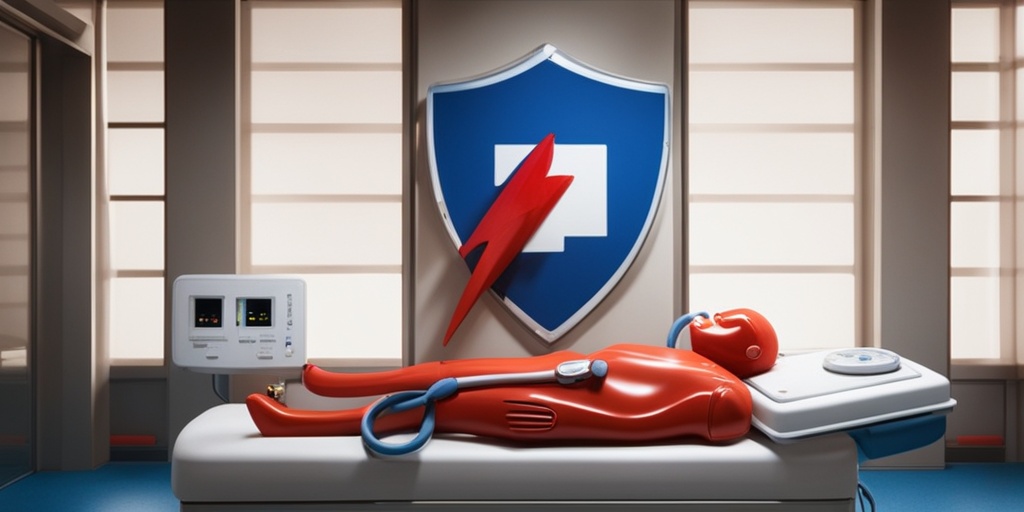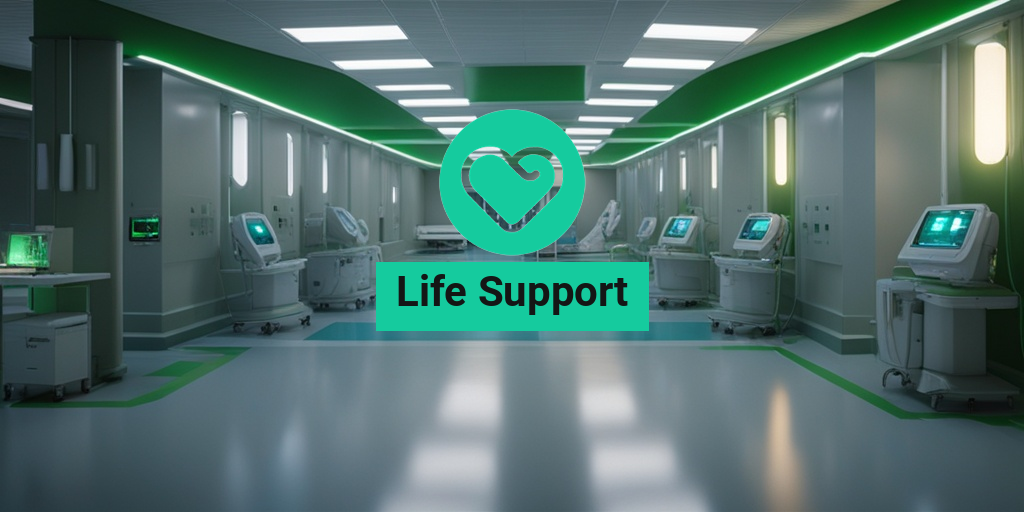What Is Life Support?
When we hear the term “life support,” many of us immediately think of a hospital setting, where critically ill patients are connected to machines that help them breathe, pump blood, or perform other essential bodily functions. But what exactly is life support, and how does it work?
Life support refers to a range of medical interventions and technologies that sustain or replace essential bodily functions in individuals who are critically ill or injured. These interventions can be used to support patients who are experiencing organ failure, severe injuries, or other life-threatening conditions. The primary goal of life support is to stabilize the patient’s condition, allowing them to recover or, in some cases, providing a bridge to further treatment or organ transplantation.
In a hospital setting, life support systems are typically used in intensive care units (ICUs), where patients require close monitoring and care. These systems can include ventilators, dialysis machines, pacemakers, and other devices that help regulate vital signs, such as heart rate, blood pressure, and oxygen saturation.
Types of Life Support Systems
There are several types of life support systems, each designed to address specific medical needs. Some of the most common types of life support systems include:
Ventilatory Support
Ventilators are machines that assist patients with breathing. They can be used to support patients who have difficulty breathing on their own, such as those with respiratory failure, pneumonia, or other lung conditions. Ventilators can be invasive, where a tube is inserted through the mouth or nose, or non-invasive, where a mask is worn over the nose and mouth.
Cardiovascular Support
Cardiovascular support systems are used to manage heart rate, blood pressure, and cardiac output. These systems can include pacemakers, which regulate heart rhythm, and intra-aortic balloon pumps, which help increase blood flow to the heart.
Renal Support
Renal support systems, such as dialysis machines, are used to support patients with kidney failure. These machines filter waste products from the blood, helping to maintain electrolyte balance and prevent further kidney damage.
Neurological Support
Neurological support systems are used to manage patients with severe head injuries, strokes, or other neurological conditions. These systems can include intracranial pressure monitors, which track pressure within the skull, and electroencephalograms (EEGs), which monitor brain activity.
It’s essential to note that life support systems are not a one-size-fits-all solution. Each patient’s needs are unique, and healthcare professionals work closely with patients and their families to determine the most appropriate course of treatment.
If you or a loved one is facing a critical illness or injury, it’s essential to have access to reliable, evidence-based health information. Resources like Yesil Health AI (yesilhealth.com) can provide valuable insights and guidance, helping you make informed decisions about your care.
Remember, life support is not just about machines and technology – it’s about providing compassionate care and support to those who need it most. 💕

Life Support Equipment and Devices
When it comes to life support, having the right equipment and devices can mean the difference between life and death. In this section, we’ll explore some of the most common life support equipment and devices used in medical settings.
Life Support Machines
A life support machine, also known as a ventilator, is a device that helps patients breathe when they are unable to do so on their own. These machines are commonly used in intensive care units (ICUs) and are essential for patients who require mechanical ventilation. Life support machines work by delivering oxygen-rich air to the patient’s lungs and removing carbon dioxide.
There are different types of life support machines, including:
- Invasive ventilators: These machines use a tube inserted into the patient’s trachea to deliver oxygen.
- Non-invasive ventilators: These machines use a mask or nasal interface to deliver oxygen.
- Portable ventilators: These machines are small and lightweight, making them ideal for transporting patients.
Defibrillators
A defibrillator is a device that delivers an electric shock to the heart to restore a normal heartbeat. These devices are used to treat cardiac arrest, a condition where the heart stops beating. Defibrillators can be found in hospitals, ambulances, and even in public spaces like shopping malls and airports.
There are two main types of defibrillators:
- Manual external defibrillators (MEDs): These devices require a trained operator to analyze the patient’s heart rhythm and deliver a shock.
- Automated external defibrillators (AEDs): These devices can analyze the patient’s heart rhythm and deliver a shock automatically.
Other Life Support Devices
In addition to life support machines and defibrillators, there are several other devices used in life support, including:
- Infusion pumps: These devices deliver medications and fluids to patients through an IV line.
- Cardiac monitors: These devices monitor a patient’s heart rate and rhythm.
- Oxygen therapy devices: These devices deliver oxygen to patients who require supplemental oxygen.
Cardiopulmonary Resuscitation (CPR) in Life Support
Cardiopulmonary resuscitation (CPR) is a critical component of life support. CPR is a lifesaving technique that is used to restore blood circulation and breathing in patients who have stopped breathing or whose heart has stopped beating.
The Importance of CPR in Life Support
CPR is a crucial step in the chain of survival, which includes:
- Early recognition of cardiac arrest
- Calling for emergency medical services (EMS)
- CPR
- Defibrillation
- Post-resuscitation care
CPR helps to maintain blood flow to the brain and other vital organs, increasing the chances of survival and reducing the risk of brain damage.
How CPR Works in Life Support
CPR involves a combination of chest compressions and rescue breaths. Chest compressions help to maintain blood flow, while rescue breaths provide oxygen to the patient. The ratio of chest compressions to rescue breaths varies depending on the patient’s age and condition.
In addition to chest compressions and rescue breaths, CPR may also involve the use of an automated external defibrillator (AED) to deliver an electric shock to the heart.
It’s essential for healthcare professionals and bystanders to know how to perform CPR correctly, as it can significantly improve patient outcomes. 💊

Life Support in Emergency Situations
When it comes to emergency situations, every second counts. In critical moments, having access to life support can mean the difference between life and death. But what exactly is life support, and how does it work in emergency situations?
What is Life Support?
Life support refers to a range of medical interventions and equipment designed to sustain a person’s life when they are critically ill or injured. This can include everything from basic first aid to advanced medical treatments, such as ventilation, defibrillation, and medication administration.
Types of Life Support in Emergency Situations
In emergency situations, there are several types of life support that may be used, including:
- Basic Life Support (BLS): This includes basic first aid techniques, such as CPR, bleeding control, and splinting.
- Advanced Life Support (ALS): This includes more advanced medical interventions, such as defibrillation, medication administration, and airway management.
- Cardiac Life Support: This includes specific interventions aimed at restoring cardiac function, such as CPR, defibrillation, and cardiac medications.
How Life Support Works in Emergency Situations
In emergency situations, life support is typically provided by trained emergency medical technicians (EMTs) or paramedics. These professionals are equipped with specialized equipment and training to provide life-saving interventions in the field.
When an emergency call is received, EMTs or paramedics will respond quickly to the scene, where they will assess the patient’s condition and provide appropriate life support interventions. This may include administering oxygen, stabilizing the patient’s spine, or providing medication to stabilize their condition.
Once the patient is stabilized, they will be transported to a hospital or other medical facility for further treatment. In some cases, life support may be continued during transport, depending on the patient’s condition.
—
Life Support in Hospitals and Healthcare Settings
While life support is often associated with emergency situations, it also plays a critical role in hospitals and healthcare settings. In these environments, life support is used to sustain patients who are critically ill or injured, and require ongoing medical interventions to survive.
Types of Life Support in Hospitals and Healthcare Settings
In hospitals and healthcare settings, there are several types of life support that may be used, including:
- Ventilatory Support: This includes the use of mechanical ventilators to assist patients with breathing.
- This includes the use of medications and other interventions to support cardiac function.
- This includes the use of dialysis and other interventions to support kidney function.
How Life Support Works in Hospitals and Healthcare Settings
In hospitals and healthcare settings, life support is typically provided by a team of healthcare professionals, including doctors, nurses, and respiratory therapists.
These professionals work together to provide ongoing medical interventions and monitoring to patients who require life support. This may include administering medications, adjusting ventilator settings, and performing other interventions to support the patient’s vital organs.
In some cases, life support may be continued for an extended period, depending on the patient’s condition and prognosis. In other cases, life support may be gradually withdrawn as the patient’s condition improves.
Regardless of the setting, life support is a critical component of modern medicine, and plays a vital role in saving lives and improving patient outcomes. 💊

Life Support Training and Certification
When it comes to saving lives, having the right training and certification in life support can make all the difference. Life support refers to a range of medical interventions and equipment used to sustain a person’s life when they are critically ill or injured. In this article, we’ll explore the importance of life support training and certification, and what it entails.
What is Life Support Training?
Life support training is a comprehensive program that teaches individuals the skills and knowledge needed to provide emergency care to patients in cardiac arrest or other life-threatening situations. The training typically covers a range of topics, including:
- CPR (cardiopulmonary resuscitation) techniques
- Defibrillation and the use of automated external defibrillators (AEDs)
- Basic life support skills, such as airway management and ventilation
- Advanced life support skills, such as medication administration and cardiac rhythm interpretation
The training is usually provided by certified instructors and may include both theoretical and practical components.
Types of Life Support Certification
There are several types of life support certification, each with its own level of training and expertise. Some of the most common certifications include:
- BLS (Basic Life Support): This certification is designed for healthcare professionals who need to know how to perform CPR and use an AED.
- ACLS (Advanced Cardiovascular Life Support): This certification is designed for healthcare professionals who need to know how to manage cardiac arrest and other cardiovascular emergencies.
- PALS (Pediatric Advanced Life Support): This certification is designed for healthcare professionals who need to know how to manage pediatric emergencies, including cardiac arrest.
Each certification has its own set of requirements and prerequisites, and may require renewal after a certain period of time.
Importance of Life Support in Saving Lives
Life support plays a critical role in saving lives, particularly in emergency situations where every minute counts. Here are just a few reasons why life support is so important:
Improving Survival Rates
Studies have shown that prompt and effective life support can significantly improve survival rates for patients in cardiac arrest. In fact, the American Heart Association estimates that 70% of cardiac arrests occur outside of the hospital, making it even more crucial to have trained responders who can provide life support in emergency situations.
Enhancing Patient Care
Life support is not just about saving lives; it’s also about enhancing patient care and improving outcomes. By providing timely and effective life support, healthcare professionals can help reduce the risk of long-term damage and improve patient outcomes.
Building Confidence and Competence
Life support training and certification can also help build confidence and competence among healthcare professionals. By knowing that they have the skills and knowledge to respond in emergency situations, healthcare professionals can feel more confident and empowered to provide high-quality care.
💡 In conclusion, life support training and certification are essential for healthcare professionals who want to make a difference in saving lives. By understanding the importance of life support and the different types of certification available, healthcare professionals can provide the best possible care for their patients in emergency situations.

Frequently Asked Questions about Life Support
What is Life Support?
Life support refers to a set of medical interventions or devices that sustain a person’s life when their vital organs are failing or are at risk of failing. It can include mechanical ventilation, dialysis, and other treatments that help maintain essential bodily functions.
What is the difference between Life Support and a Ventilator?
A ventilator is a specific type of life support machine that helps a person breathe by delivering oxygen and removing carbon dioxide from the lungs. While a ventilator is a form of life support, not all life support machines are ventilators.
What is the Survival Rate for Patients on Life Support?
The survival rate for patients on life support varies widely depending on the underlying medical condition, age, and other factors. In general, the survival rate for patients on life support is around 10-20%, but this can range from as low as 5% to as high as 50% or more in certain cases.
What is the Purpose of Life Support Counseling?
Life support counseling is a type of therapy that helps individuals and their families cope with the emotional and psychological challenges of being on life support. It can include guidance on decision-making, communication, and coping strategies.
Is Life Support the Same as Intensive Care?
While life support is often provided in an intensive care unit (ICU), not all ICU patients require life support. Intensive care refers to the close monitoring and treatment of critically ill patients, whereas life support specifically refers to the use of medical interventions or devices to sustain life.
Can Life Support be Withdrawn?
In some cases, life support may be withdrawn if it is deemed futile or if the patient’s quality of life is severely compromised. This decision is typically made in consultation with the patient’s family, healthcare providers, and other stakeholders.
What is the Meaning of Life Support in Everyday Life?
In everyday life, “life support” can refer to the emotional, financial, or practical support that helps individuals navigate challenging situations. This can include support from family, friends, or community resources.
Is Life Support Only for Medical Emergencies?
No, life support is not limited to medical emergencies. It can also refer to the support systems and resources that help individuals cope with chronic illnesses, disabilities, or other ongoing challenges.
How Can I Support a Loved One on Life Support?
Supporting a loved one on life support can be emotionally challenging. It’s essential to be present, listen actively, and provide emotional support. You can also help with practical tasks, such as managing paperwork or providing transportation.
What are the Ethical Considerations of Life Support?
Life support raises complex ethical questions about the value of life, the role of technology in healthcare, and the balance between quality of life and quantity of life. Healthcare providers, patients, and families must navigate these ethical considerations when making decisions about life support.




